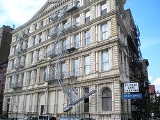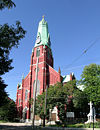
Henry Engelbert
Encyclopedia
Henry Engelbert was an architect best known for buildings in the French Second Empire style, which emphasized elaborate mansard roofs with dormers. New York's Grand Hotel on Broadway is the most noteworthy extant example of Engelbert's work in the French Second Empire Style. Also, many of his commissions were Lutheran or Roman Catholic churches.
Although Engelbert was born in Germany, he established his practice in New York City
. One historian has stated that he established his office in 1852, in partnership with John Edson, and their office was at 85 Nassau Street in New York City. However, at least one of Engelbert's commissions predates the 1852 opening of his office.



Although Engelbert was born in Germany, he established his practice in New York City
New York City
New York is the most populous city in the United States and the center of the New York Metropolitan Area, one of the most populous metropolitan areas in the world. New York exerts a significant impact upon global commerce, finance, media, art, fashion, research, technology, education, and...
. One historian has stated that he established his office in 1852, in partnership with John Edson, and their office was at 85 Nassau Street in New York City. However, at least one of Engelbert's commissions predates the 1852 opening of his office.
Notable Buildings: New York City
In chronological order:
- Church of the TransfigurationChurch of the Transfiguration (New York City)The Church of the Tranfiguration is a Roman Catholic parish located at 25 Mott Street on the northwest corner of Mosco Street in the Chinatown neighborhood of Manhattan, New York City...
(formerly Zion English Lutheran Church), 1801, 25 Mott Street. This church has a Georgian Gothic style. This should not be confused with the Episcopal church of the same name on East 29th Street. - Fifth Avenue Baptist Church, 1856, since demolished. The architects of this church are given as "Edson and Engelbert", referring to John Edson, Engelbert's office partner.
- College of Mount Saint VincentCollege of Mount Saint VincentFor the university in Halifax, Nova Scotia, see Mount Saint Vincent University The College of Mount Saint Vincent is a Catholic liberal arts college located in the northeast corner of the Riverdale section of The Bronx, New York, adjacent to the Yonkers border. It is the northernmost location in...
Administration Building (originally Convent and Academy of Mount Saint Vincent), 1859, 6301 Riverdale Avenue at West 263rd Street. - Church of Our Lady of SorrowsChurch of Our Lady of Sorrows (New York City)The Church of Our Lady of Sorrows is a Roman Catholic parish church in the Roman Catholic Archdiocese of New York, located at 105 Pitt Street and Stanton Street, Manhattan, New York City. The area was formerly known as Kleindeutschland . It was established in 1867 as Our Lady of the Seven Dolors...
(now Mision Guadalupana), 1867–1868, 101-103 Pitt Street at Stanton Street.

- Grand HotelGrand Hotel (New York, New York)The Grand Hotel is located in Manhattan in New York City. The building was built in 1868 and was added to the National Register of Historic Places on September 15, 1983. It is now a residence.-See also:...
(now Clark Apartments), 1868, 1232-1238 Broadway at West 31st Street. It was built in the French Second Empire style for carpet magnate Elias S. Higgins, who later commissioned Engelbert to design the Grand Central HotelGrand Central HotelThe Grand Central Hotel, later renamed the Broadway Central Hotel, was a hotel at 673 Broadway, New York City, that collapsed on August 3, 1973, killing four residents and injuring at least twelve.-History:...
. - St. Patrick's Old Cathedral, New YorkSt. Patrick's Old Cathedral, New YorkThe Basilica of Saint Patrick's Old Cathedral, or Old St. Patrick's, is located at 260-264 Mulberry Street between Prince and Houston Streets in the Nolita neighborhood of Manhattan, New York City, with the primary entrance currently located on Mott Street...
, 1868 restoration by Engelbert of the original 1815 structure designed by Joseph Mangin. This church, located at 260-264 Mulberry Street, has been famous for its role in the New York Draft RiotsNew York Draft RiotsThe New York City draft riots were violent disturbances in New York City that were the culmination of discontent with new laws passed by Congress to draft men to fight in the ongoing American Civil War. The riots were the largest civil insurrection in American history apart from the Civil War itself...
of 1863 and in the book and film, The Gangs of New York, which dealt with those events. This St. Patrick's should not be confused with the current St. Patrick's Cathedral, New YorkSt. Patrick's Cathedral, New YorkThe Cathedral of St. Patrick is a decorated Neo-Gothic-style Roman Catholic cathedral church in the United States...
on Fifth Avenue. - Elias S. Higgins Warehouse and Store, (1868–1869): 424-426 Broadway. This six-story building has a cast iron facade and was designed in a French Second Empire style for carpet manufacturer Elias S. Higgins. This is one of three buildings that Higgins commissioned Engelbert to design. The building has been converted into residential lofts.
- Holy Cross Roman Catholic ChurchHoly Cross Church (New York City)Holy Cross Church is a Roman Catholic church located at 329 West 42nd Street between Eighth and Ninth Avenues in the Hell's Kitchen neighborhood of Manhattan, New York City, near Times Square and across the street from the Port Authority Bus Terminal....
(Church of the Holy Cross), 1870, 329-333 West 42nd Street. This Byzantine style church near Times SquareTimes SquareTimes Square is a major commercial intersection in the borough of Manhattan in New York City, at the junction of Broadway and Seventh Avenue and stretching from West 42nd to West 47th Streets...
was associated with Father Francis P. DuffyFrancis P. DuffyFrancis Patrick Duffy was an American soldier, Roman Catholic priest and chaplain. As the chaplain for the "Fighting 69th", he became the most highly decorated cleric in the history of the U.S. Army. Duffy Square, the northern half of Times Square, is named after him.-Early life and...
, the famed army chaplain of World War IWorld War IWorld War I , which was predominantly called the World War or the Great War from its occurrence until 1939, and the First World War or World War I thereafter, was a major war centred in Europe that began on 28 July 1914 and lasted until 11 November 1918...
. - Grand Central HotelGrand Central HotelThe Grand Central Hotel, later renamed the Broadway Central Hotel, was a hotel at 673 Broadway, New York City, that collapsed on August 3, 1973, killing four residents and injuring at least twelve.-History:...
(later Broadway Central Hotel), 1870, 673 Broadway. This was the second commission for a hotel that Engelbert received from carpet magnate Elias S. Higgins, and in many ways it is a larger, more flamboyant version of Engelbert's 1868 Grand Hotel further north on Broadway. In 1973 this hotel abruptly collapsed, killing four residents. It appears that the removal of load-bearing walls in the basement, as part of a remodeling project, led to the structure's collapse. - Bouwerie Lane TheatreBouwerie Lane TheatreThe Bouwerie Lane Theatre is a former bank building which became an Off-Broadway theatre, located at 330 Bowery at Bond Street in Manhattan, New York City....
(previously Bond Street Savings Bank Building, and originally Atlantic Savings Bank Building), 1874, 330 Bowery. This building, with its cast iron facade, combines Corinthian columns with Second French Empire elements.
Notable Buildings: Other Locations
In chronological order:
- St. Mary's Abbey Church, 1856–1857, Martin Luther King Boulevard at William Street, Newark, New Jersey. Now known as Newark Abbey.
- Trinity Evangelical Lutheran Church and Parsonage, 1874–1975, 72 Spring Street at Hone Street, Kingston, New York.
- Sampson-Freeman Building, 1875, 1 Broadway at West Strand, Kingston, New York. This three-story building originally consisted of a store on the ground floor, with an opera house on the upper floors. A mansard roof and tower were lost in an 1885 fire. However, cast iron pillars at the ground level have survived to the present day.
- St. Albertus Roman Catholic ChurchSt. Albertus Roman Catholic ChurchSt. Albertus Roman Catholic Church is a church located at 4231 St. Aubin Street in Detroit, Michigan in the Forest Park neighborhood area on the city's central East side...
, 1885, 4231 St. Aubin Street, Detroit. This structure was built for Detroit's Polish Catholics in a style that has been described as Polish Gothic Revival. - St. Mary of Perpetual HelpSt. Mary of Perpetual HelpSt. Mary of Perpetual Help - historic church of the Roman Catholic Archdiocese of Chicago located in the Bridgeport neighborhood of Chicago, Illinois....
Roman Catholic Church, 1892, 1035 West 32nd Street, Chicago. This RomanesqueRomanesque Revival architectureRomanesque Revival is a style of building employed beginning in the mid 19th century inspired by the 11th and 12th century Romanesque architecture...
church was built for the Polish Catholic community of Chicago's South Side.

